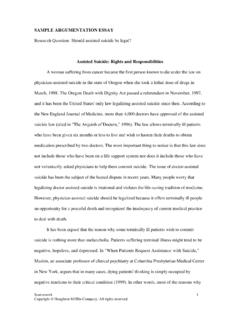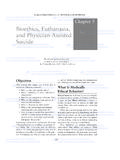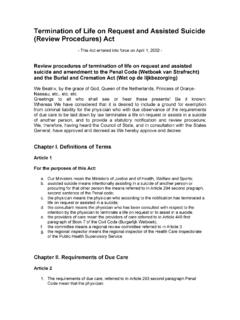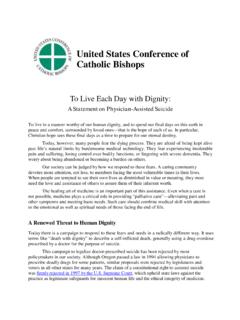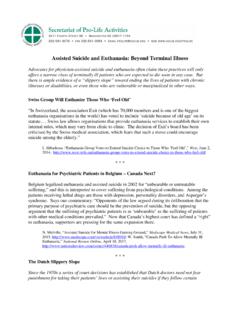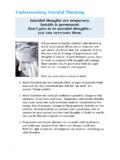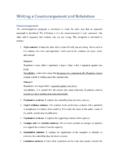Transcription of Tools for Screening and Assessment of Suicide Risk
1 Tools for Screening and Assessment of Suicide Risk Screening 1. High School Questionnaire: Profile of Experiences Leona L. Eggert, , , FAAN; Jerald R. Herting, , and Elaine A. Thompson , RN. Description: The High School Questionnaire: Profile of Experience (HSQ) is a 3-part questionnaire designed specifically for high school adolescents to measure psychosocial risk and protective factors such as depression, suicidal behaviors, drug involvement, family factors, daily activities, personal strengths, and social support. Embedded in the HSQ, is the Suicide Risk Screen (SRS), which examines adolescent suicidal behavior.
2 The (SRS) scale includes 3 sets of empirically based criteria: 1) suicidal behaviors (2) depression 3) drug involvement. Availability: Not currently available, in preparation for distribution. Related Publications: Thompson, E. A., & Eggert, L. L. (1999). Using the Suicide Risk Screen to identify suicidal adolescents among potential high school dropouts. Journal of the American Academy of Child & Adolescent Psychiatry, 38(12), 1506-1514. 2. Suicidal Ideation Questionnaire (SIQ) William M. Reynolds, Description: The SIQ is useful for Screening adolescents for suicidal ideation one aspect of suicidal behavior that may point to suicidal intentions.
3 The SIQ is appropriate for individual or group administration in clinical or school settings, or for the evaluation of intervention and prevention programs. Two versions of the SIQ are available: a 30-item format for adolescents in grades 10 12, and the 15-item SIQ-JR, for adolescents in grades 7 9. Both forms use a 7-point scale to assess the frequency of suicidal thoughts and ideas. Availability: The SIQ can be obtained from Psychological Assessment Resources Inc. available on the Web at Related Publications: Reynolds, W.
4 M. (1987). Suicidal Ideation Questionnaire: Professional Manual. Psychological Assessment Resources Inc. Reynolds, W. M. (1991). A school-based procedure for the identification of adolescents at risk for suicidal behaviors. Family Community Health, 14, 64-75. Pinto, A., Willsman, M. A., & McCoy, K. J. M. (1997). Suicidal ideation in adolescents: Psychometric properties of the Suicidal Ideation Questionnaire in a clinical sample. Psychological Assessment , 9, 63-66. 2 Reynolds, W. M., & Mazza, J. J. (1999). Assessment of suicidal ideation in inner-city children and young adolescents: Reliability and validity of the Suicidal Ideation Questionnaire-JR.
5 School Psychology Review, 28, 17-30. 3. Columbia Health Screen (CHS) David Shaffer, , , Psych. Description: The Columbia Health Screen, a brief self-report questionnaire, is designed for paper and pencil administration and takes approximately 10 minutes to complete. This screen is designed for youth aged 11 to 18. The 14-item questionnaire includes items on depression, anxiety, Suicide -risk behaviors ( , Suicide ideation and attempts), alcohol and drug use, and general health problems. Availability: Information regarding the Columbia Health Screen is available on the Web at Related Publications: Shaffer, D.
6 , Scott, M., Wilcox, H., Maslow, C., Hicks, R., Lucas, C., Garfinkel, R., & Greenwald, S. (2004) The Columbia SuicideScreen: Validity and reliability of a screen for youth Suicide and depression. Journal of the American Academy of Child & Adolescent Psychiatry, 43(1), 71-79. 3 Assessment 1. Suicidal Behaviors Interview (SBI) William M. Reynolds, Description: The SBI is designed to evaluate current suicidal behaviors in adolescents. The interview contains 22 items, organized into two sections. The first section consists of four sets of questions specific to: 1) generalized level of psychological distress, including anxiety, depression, and hopelessness; 2) severity of daily chronic strains; 3) level of social support; and 4) evaluation of recent major negative life events.
7 These four domains are related to suicidal behaviors in adolescents. The second section consists of questions specific to suicidal behavior and related risk factors. The section follows a hierarchy of suicidal cognitions and behaviors ranging from mild suicidal ideation through items dealing with specific thoughts to contemplated plans. There are branch patterns built into the interview schedule based on the adolescent's response to the questions. Availability: For information contact William M. Reynolds Chair, Department of Psychology at Humboldt State University, 1 Harpst Street, Arcata, CA 95521-8299; by phone at 707-826-3162; or E-mail: Related Publications: Reynolds (1990).
8 Development of a semi-structured clinical interview for suicidal behaviors in adolescents. Psychological Assessment , 2, 382 390 2. Screen Interview for Youth Suicide Risk (SIYSR) Elaine A. Thompson, ; ; Leona L. Eggert, , , FAAN; and Jerald R. Herting, Description: The SIYSR is a brief interview administered to youth one-on-one following identification of the youth s potential risk for Suicide ( , responses on a paper and pencil Screening questionnaire, personal observation of risk and/or ad hoc referral for Screening ).
9 The SYSR is a 24-item structured interview based on a risk and protective factor model. These items represent 3 main dimensions of overall Suicide potential; 1) Suicide Risk Factors, reflected by Suicide thoughts, Suicide behaviors and prior attempts;2) Related Risk Factors, namely, emotional distress (depression/hopelessness, stress, and anger) and deviant behaviors (drug involvement, risky behaviors and school deviance; and 3) Protective Factors, including satisfaction with, and perceived availability of support. Skip patterns are built into the interview to avoid educating youth about suicidal behaviors; that is, if a youth has never had a Suicide plan, s/he is not asked questions about planning.
10 Availability: Not currently available, in preparation for distribution. 3. Measurement of Adolescent Potential for Suicide (MAPS) Leona L. Eggert, , , FAAN; Elaine A. Thompson, , ; and Jerald R. Herting, Description: The Measure of Adolescent Potential for Suicide (MAPS) is a comprehensive, multidimensional, computer-assisted interview administered over to 2 hours to youth identified as at risk for Suicide . The interview is tailored to the developmental needs of the adolescent, and is structured to enhance rapport building; at key points the interviewer is prompted to be responsive to the youth s needs for affirmations and empathy.
